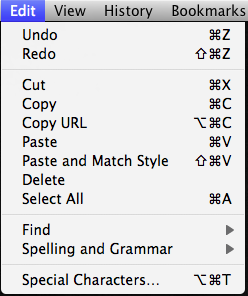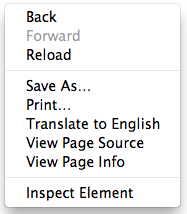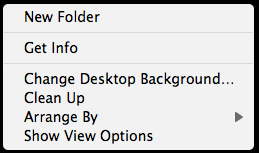Inside: Email attachments, Emailing web pages, What’s on the Menu?
Big announcements from Apple this week! The two most relevant to Mac users are:
- A new version of their Mac OS X operating system. It will be upgradeable only from Snow Leopard, will be available only in the App Store, and will cost only $29.99. Of course it’s named after another cat, this time it’s called Lion. I don’t know if it’s worth a “roar!” yet but there are definitely some interesting looking new features. But I want to hear what you think. Reply to this email and tell me what features interest you the most. You can check out the new features here: https://www.apple.com/macosx/
- MobileMe will be going away, replaced by the much more capable iCloud service in the Fall. You can read more about iCloud here:Â https://www.apple.com/icloud/
While Apple was busy announcing new products, I was busy making videos about email, inspired by numerous questions from readers. What I thought might be a boring topic became a lot of fun because I learned a few new tricks along the way. The videos are a couple minutes longer than usual but, don’t worry, I kept the articles shorter because the pictures are definitely worth a thousand words.
Attaching files to an email
As I was making these videos (one for Apple Mail and one for GMail), I kept learning new ways to attach a file to an email message. Then I was surprised to find that Apple Mail and GMail will also resize inserted photos for you if you like. Very cool!
How to attach files to emails in Apple Mail
How to attach files to emails in GMail
Emailing a web page to your friends
My Mom and reader Susanne both asked me about the best way to email a web page. I would have given a boring copy-and-paste answer if reader Betty hadn’t recently taught me about a cool Safari feature, which then led me to learn of a related feature in Safari, Firefox and Google Chrome.
Watch this video to learn these time-saving tricks and read the article for tips on when to email a link to a web page and when to send its contents.
I would have learned about these features sooner if I’d only listened to my own advice and taken a stroll through the menus of the applications I use everyday. That’s why…
The word is “menu”.
You’re probably most familiar with menus at the top of your screen. They are in the upper left and look something like this:
That’s called the menu bar. Each word or symbol represents a menu of related options.
Just as a restaurant’s menu will change from breakfast to lunch to dinner, the menu bar changes depending on which application you are currently using. But, whichever you’re using, the menu bar will almost always have this basic structure from left to right:
- Apple Menu (this is the one menu that doesn’t change)
- Application Menu (also handy way to identify the current application)
- File Menu
- Edit Menu
- other menus depending on the application
- Window Menu
- Help Menu
I highly recommend browsing through the menu options of your favorite applications. Not only will you get a feel for what types of things the application can do, on the right side of each menu, you’ll also see the shortcut keystrokes for many of the functions.

You absolutely won’t hurt anything by just looking and not clicking. And much of the time you won’t do anything irreversibly bad even if you do click on a menu option (as long as you are wary of words like “delete” and “erase”). Menu options that end with “…” are especially good places to start exploring since the “…” means that clicking on that option will open up a new window with more settings or options for you to explore.
Just remember these two rules:
- SAVE your work before you try something new.
- If you ever think you’ve done something bad, remember that “Undo” is always in the “Edit” menu.
If the menus on the menu bar are like a restaurant’s regular menus, then contextual menus are like “Today’s Specials”. Contextual menus (also known as shortcut or popup menus) change depending on where the mouse pointer is. Just control-click (click the mouse button while pressing the “control” key) or right-click (if your mouse or trackpad has a right button) almost anywhere on your screen and a contextual menu will pop up.
Here’s one for empty web page space in Chrome:

And here’s one for the Desktop:

As you can see, each is a short list of functions that the system thinks you are most likely to want to perform on whatever you were clicking on.
So here’s your two-part assignment for the week:
- Take a leisurely stroll throw the menus of whatever application you’re using to read this newsletter.
- (Bonus) Control-click (or right-click) on the word “menu” and choose the “Look Up in Dictionary” option. Did you know you had a pretty good Dictionary built into your Mac? Did you know you could access it this easily?
Mac Help For Mom on Facebook
Do you use Facebook? It’s another way to learn about new Mac Help For Mom videos and interact with other people who like Mac Help For Mom. If you click the “Like” button on the Mac Help For Mom Facebook page then you’ll see the Mac Help For Mom Facebook posts in your Facebook News Feed, be able to comment on them, and join in the discussions.
I found your website today, and wanted to thank you for teaching me more about my Mac. Loved learning to use special characters, and next I am going to make my Mac talk. I know I haven’t been using even 1% of what this MacBook Pro (10.6.8) is capable of. I am equally underutilizing my iPhone 3GS (4.3.3). It feels great to be able to use some feature that has just been sitting there idle. Your Mom is a lucky lady. Please keep up the good work.
Well, thank you, Gloria! Be sure to sign up for my weekly newsletter so I can tell you about new articles and videos. Just use the form in the pink box on the righthand side of this page.